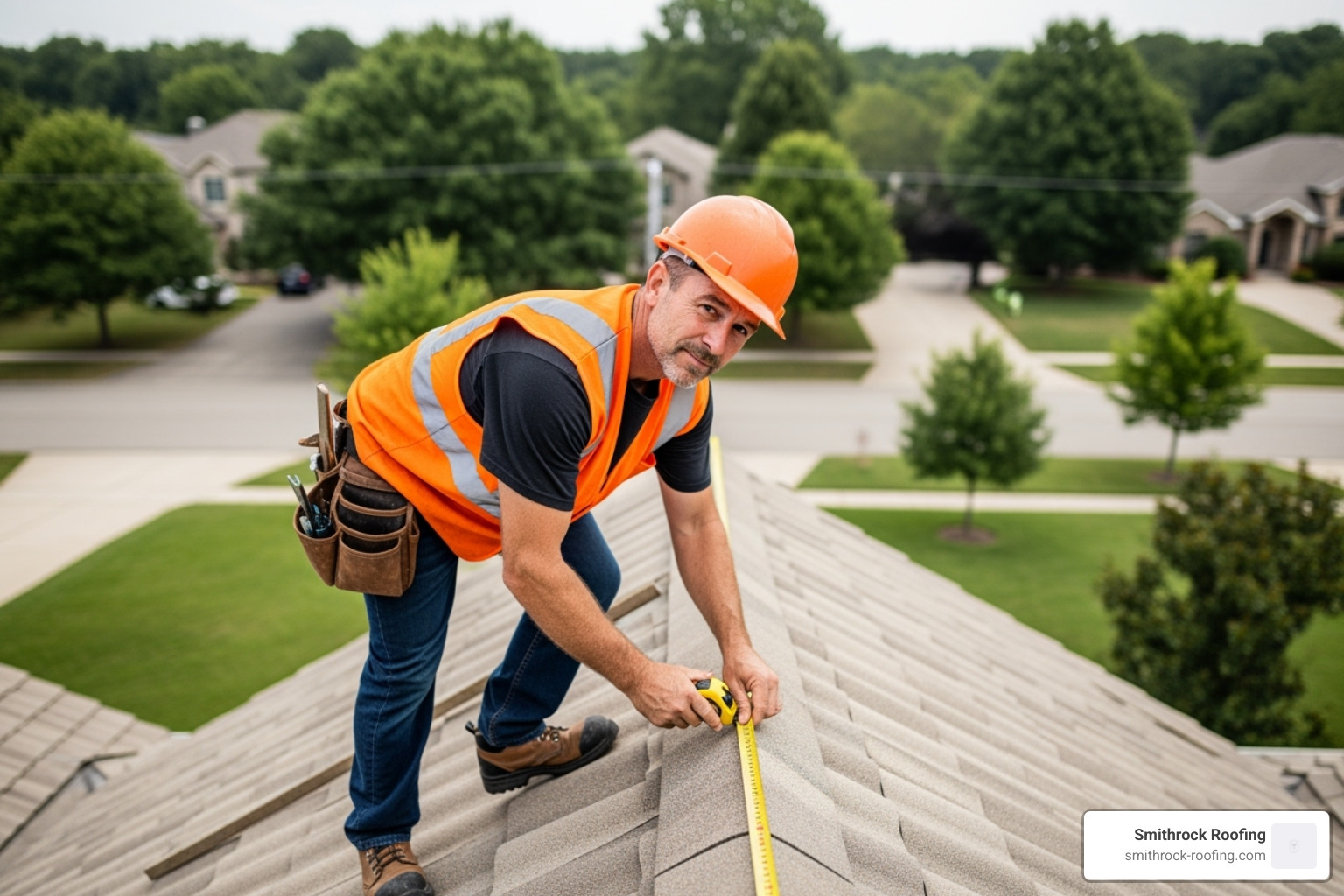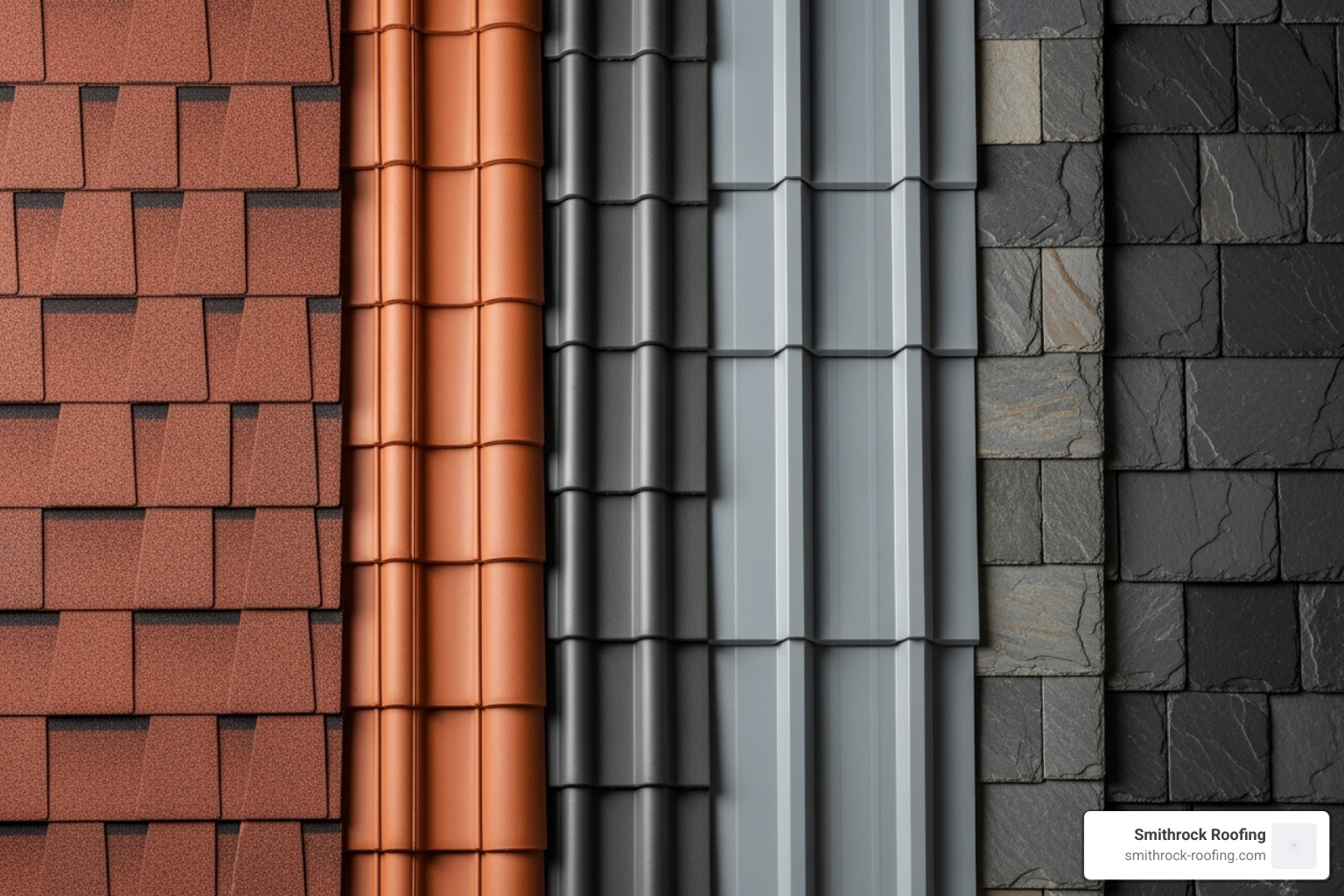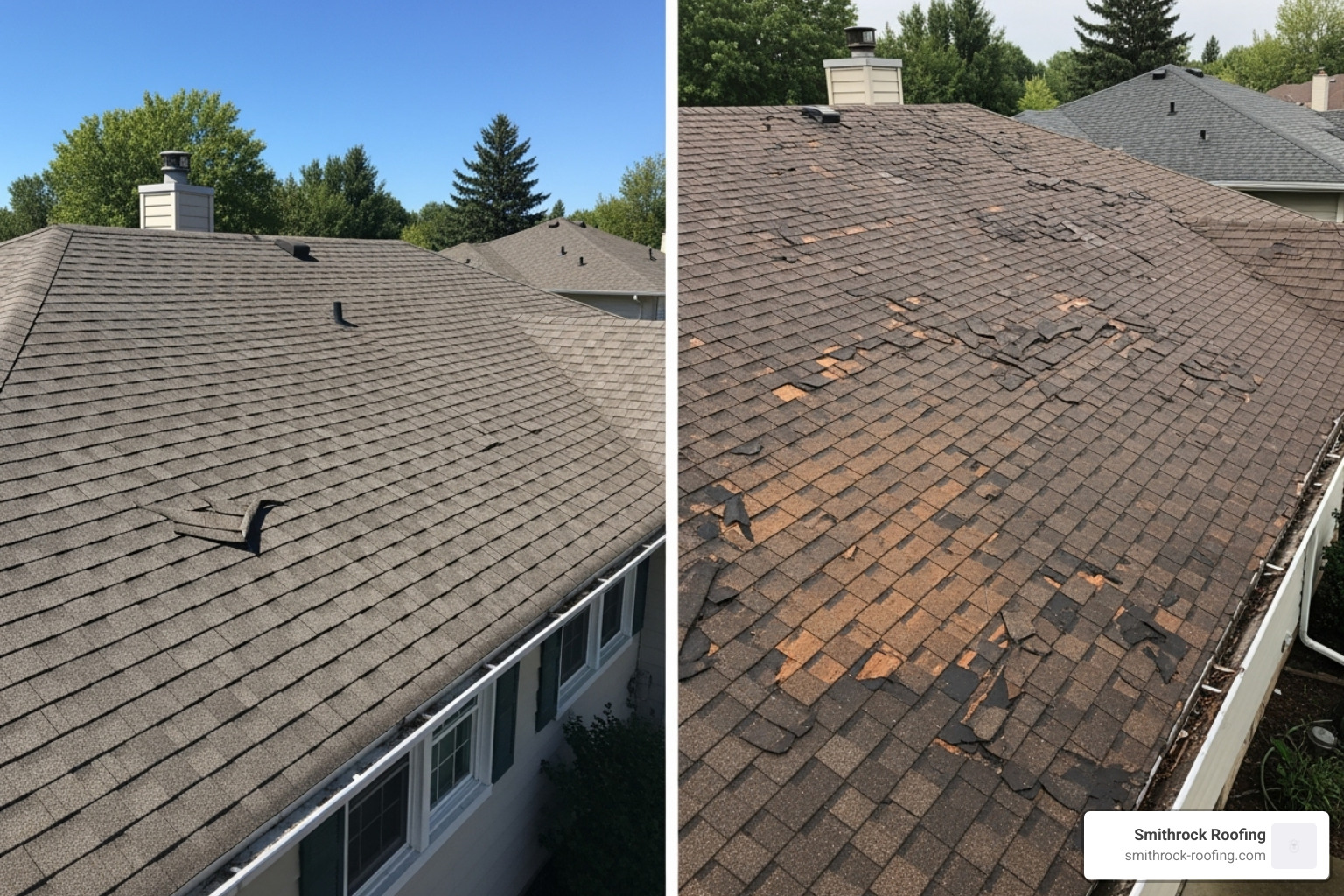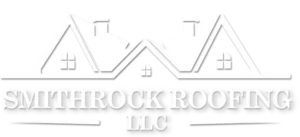For most homeowners in North Carolina, roof replacement costs typically range from $7,251 to $11,084, with the average investment sitting around $9,000 to $11,000. This significant investment protects your home from the elements while potentially providing up to a 60% return on investment when you sell.
Quick Cost Breakdown:
Several key factors dramatically impact your final price. Roof size and pitch determine the complexity of the job, while material choice affects both upfront costs and long-term value. Your location within the Triad influences labor rates, and underlying damage can add thousands to your budget.
The stakes are high when it comes to roof replacement. As one roofing expert notes, “A roofing problem does not fix itself. The problem can snowball into other issues, such as mold and wood rot.” This makes understanding the true costs – and investing in quality materials and professional installation – crucial for protecting your home’s value and your family’s safety.
Roof replacement represents one of the largest home improvement investments most homeowners will make. Unlike smaller projects that can be postponed or done gradually, a failing roof demands immediate attention. Water damage from a compromised roof can quickly spread throughout your home, affecting insulation, drywall, flooring, and even your home’s foundation. The cost of addressing these secondary issues often exceeds the original roof replacement investment by thousands of dollars.
In North Carolina’s climate, roofs face unique challenges that homeowners in other regions don’t encounter. Our humid summers create ideal conditions for algae and moss growth, while seasonal storms bring high winds, hail, and heavy rainfall that can damage even well-maintained roofs. The freeze-thaw cycles during winter months can cause shingles to crack and expand, creating entry points for water infiltration.
Understanding roof replacement costs also means recognizing the long-term financial benefits of this investment. Energy-efficient roofing materials can significantly reduce cooling costs during North Carolina’s hot summers. Proper ventilation systems installed during roof replacement help regulate attic temperatures, reducing strain on HVAC systems and extending their lifespan. These ongoing savings often offset a significant portion of the initial investment over the roof’s lifetime.
At Smithrock Roofing, with over 15 years in exterior construction, we’ve helped countless homeowners in the Winston-Salem area steer roof replacement costs and make informed decisions about this major investment. Our experience has shown us that understanding these costs upfront helps homeowners budget properly and avoid costly surprises during their project. We’ve seen how proper planning and realistic budgeting lead to better outcomes and higher satisfaction with the final result.

Quick roof replacement costs terms:
While national averages provide a ballpark, costs in the Winston-Salem area are what truly matter for your budget. For a typical asphalt shingle roof replacement in the Triad, homeowners can expect to invest between $7,250 and $11,000. This breaks down to roughly $4.35-$11 per square foot for both materials and labor. On a standard 1,700 sq ft roof, a straightforward asphalt shingle project often lands near $7,100-$9,400.
Keep two rules of thumb in mind:
On a $10,000 project, that’s about $6,000 paid to the crew and $4,000 for shingles, underlayment, and other components. A new roof not only protects your home from North Carolina’s humid summers and seasonal storms but also delivers a solid return on investment, with materials like metal and architectural shingles offering exceptional longevity and performance.
The Triad region’s specific market conditions significantly influence these costs. Winston-Salem, Greensboro, and High Point each have slightly different labor markets, permit requirements, and building codes that can affect your final investment. Urban areas typically see higher labor costs due to increased demand and higher living expenses, while rural areas might face additional transportation costs for materials and crews.
Local building codes in the Triad have evolved to address North Carolina’s specific weather challenges. These requirements often mandate upgraded underlayment, improved flashing systems, and improved wind resistance ratings that weren’t required in older installations. While these upgrades add to the initial cost, they provide crucial protection against the severe weather events that have become increasingly common in our region.
Seasonal demand patterns also affect pricing in the Triad. Spring and early summer typically see the highest demand as homeowners address winter damage and prepare for storm season. Contractors often offer better pricing during fall and winter months when demand decreases. However, emergency repairs following major storms can temporarily drive prices higher due to increased demand and material shortages.

Every 1,000 sq ft of roof generally costs $4,350-$11,000 to replace. A steep 12:12 roof exposes roughly 10 % more surface area than a flat footprint, so both material and labor costs climb accordingly.
Roof complexity extends beyond simple pitch calculations. Homes with multiple roof lines, valleys, dormers, skylights, and chimneys require additional flashing, custom cuts, and specialized installation techniques. Each of these features adds both material costs and labor time. A simple gable roof might take two days to complete, while a complex hip roof with multiple dormers and skylights could require a full week.
Accessibility plays a crucial role in pricing that many homeowners overlook. Homes surrounded by landscaping, tight lot lines, or multiple stories require additional safety equipment and slower work pace. Crews may need to hand-carry materials to avoid damage to property, use smaller equipment, or implement additional safety measures that increase labor costs.
Professional roofers in our area charge $45-$75 per hour or $1.50-$4 per square foot for labor alone. Most residential projects in the Triad wrap up in 2-3 workdays with a 3-4-person crew. Extra stories, skylights, or tight property access can raise that price because crews move slower and require more safety precautions.
Labor costs in the Triad reflect the skilled nature of professional roofing work. Experienced crews command higher wages because they work more efficiently, make fewer mistakes, and deliver superior results. The investment in skilled labor pays dividends through faster completion times, better workmanship, and fewer callbacks for warranty issues.
Weather delays can affect labor costs, particularly during North Carolina’s unpredictable spring and summer months. Professional contractors build weather contingencies into their scheduling and pricing, but extended delays can sometimes result in additional costs. This is another reason why off-season installations often provide better value.
For a step-by-step look at how we keep labor efficient, visit our roof installation process page.

Material choice accounts for about 40 % of your budget and determines how long you’ll go before paying for another roof. If you’d like a deeper dive into how each product is manufactured, this asphalt shingle overview is a good starting point.
The roofing material you select impacts far more than just the initial cost. Different materials perform differently in North Carolina’s climate, offer varying levels of energy efficiency, and require different maintenance approaches over their lifetime. Understanding these long-term implications helps homeowners make informed decisions that balance upfront investment with lifetime value.
Modern roofing materials incorporate advanced technologies that weren’t available even a decade ago. Impact-resistant shingles can withstand hail damage that would destroy traditional materials. Cool roof technologies reflect more sunlight and absorb less heat, reducing cooling costs. Some materials now include algae-resistant treatments that prevent the black streaking common on North Carolina roofs.
Asphalt shingles dominate the North Carolina market for good reason. They offer excellent value, proven performance, and wide availability of contractors experienced in their installation. Modern architectural shingles provide dimensional appearance that mimics more expensive materials while delivering reliable protection against our region’s weather challenges.
The quality range within asphalt shingles is substantial. Basic three-tab shingles meet minimum requirements but offer limited wind resistance and shorter lifespans. Premium architectural shingles include features like impact resistance, algae protection, and improved wind ratings that justify their higher cost through improved performance and longevity.
Warranty coverage varies significantly among asphalt shingle manufacturers. Some offer basic material warranties, while others provide comprehensive coverage including labor costs for defect-related failures. Understanding warranty terms helps homeowners evaluate the true long-term value of different shingle options.
Metal roofing has gained significant popularity in North Carolina as homeowners recognize its long-term value proposition. While the initial investment exceeds asphalt shingles, the extended lifespan and energy savings often result in lower total cost of ownership. Metal roofs typically outlast two or three asphalt roof replacements.
The variety within metal roofing options is extensive. Standing seam systems offer superior weather protection and modern aesthetics but require specialized installation expertise. Metal shingles and tiles provide the appearance of traditional materials with metal’s durability benefits. Each style has different cost implications and performance characteristics.
Installation quality becomes even more critical with metal roofing. Proper fastening, thermal expansion accommodation, and flashing details require specialized knowledge. Poor installation can lead to leaks, noise issues, and premature failure that negates metal roofing’s advantages.
| Material | Cost (installed) | Lifespan | Key Consideration |
|---|---|---|---|
| Clay Tile | $12 – $24.75 / sq ft | 40 – 50 yrs | Heavy; may need framing upgrades |
| Concrete Tile | $11 – $19.80 / sq ft | 50 yrs | Handles freeze-thaw better than clay |
| Natural Slate | $12 – $22 / sq ft | 100 yrs+ | Highest weight & upfront cost |
| Wood Shake | $8 – $14.30 / sq ft | 25 – 30 yrs | Requires periodic sealing; fire limits in some areas |
When considering heavier materials like tile or slate for your North Carolina home, it’s crucial to have a professional assess your home’s structure to ensure it can support the additional weight. Structural modifications can add $5,000-$15,000 to the project cost but are essential for safety and performance.
Premium materials like slate and tile offer best longevity and distinctive appearance that can significantly improve home value. However, they require specialized installation expertise and ongoing maintenance knowledge. Finding qualified installers and repair technicians for these materials can be challenging in some areas.
Wood shake roofing provides natural beauty and good insulation properties but requires regular maintenance in North Carolina’s humid climate. Treatment for fire resistance, periodic cleaning, and replacement of individual shakes add to the lifetime cost. Some municipalities have restrictions on wood roofing due to fire concerns.
Not sure which material matches our North Carolina climate? See our guide on Best Roofing Materials for Winston Salem Homes: Shingles, Metal, or Rubber?

A quick decision rule is the 30 % guideline: if more than 30 % of the surface is failing, replacement is usually cheaper long-term.
In the Winston-Salem area, here’s what you can generally expect:
If repair quotes creep past 25-30 % of the replacement number, it’s usually smarter to start fresh. Get more detail in our local breakdown: Roof Repair vs. Replacement in Winston Salem: What Homeowners Need to Know.
Smart timing and the right partner can shave 10-20 % off your roof replacement costs.
Need names you can trust? Check our list of Roofing Contractors in Winston Salem.
Regular inspections, clean gutters, and proper attic ventilation are key to maximizing any roof’s life in the humid North Carolina climate.
Roof lifespan depends heavily on installation quality, maintenance practices, and local weather conditions. North Carolina’s climate presents unique challenges that can shorten roof life if not properly addressed. High humidity promotes algae and moss growth, while UV exposure from intense summer sun degrades materials over time.
Proper attic ventilation plays a crucial role in roof longevity that many homeowners overlook. Inadequate ventilation causes heat and moisture buildup that can warp decking, promote ice dam formation, and accelerate shingle deterioration. Upgrading ventilation during roof replacement often extends the new roof’s lifespan significantly.
Yes – if the damage is sudden and accidental, such as from a hurricane, hailstorm, severe thunderstorm, or falling tree common in North Carolina. Insurance won’t pay for normal wear, neglect, or age. File claims quickly, and know your wind/hail deductible may differ from your standard one.
Insurance coverage for roof damage has become increasingly complex as carriers seek to limit exposure to weather-related claims. Many policies now include separate deductibles for wind and hail damage, age-based depreciation schedules, and specific exclusions for certain types of damage. Understanding your policy details before you need to file a claim helps set realistic expectations.
Documentation plays a critical role in successful insurance claims. Photos of damage, maintenance records, and professional inspection reports strengthen your claim and speed the adjustment process. Some homeowners find it beneficial to have annual roof inspections that create a documented history of the roof’s condition.
Working with contractors experienced in insurance claims can significantly improve outcomes. These professionals understand insurance requirements, can provide detailed damage assessments, and know how to present information in ways that support claim approval. However, be wary of contractors who guarantee insurance approval or offer to waive deductibles, as these practices may violate insurance terms.
Being aware of these potential items upfront prevents budget surprises.
Hidden costs often emerge during the tear-off process when underlying issues become visible. Rotted decking, damaged fascia boards, and inadequate ventilation systems are common findies that weren’t apparent during initial inspections. Setting aside 10-20% of your budget for these contingencies helps avoid project delays and financial stress.
Upgrading related systems during roof replacement often provides better value than addressing them separately later. New gutters, improved ventilation, and improved insulation can be installed more efficiently when the roof is already being replaced. These improvements often qualify for energy efficiency rebates that offset their cost.
Selecting the right contractor significantly impacts both the cost and quality of your roof replacement. Start by verifying licensing, insurance, and Better Business Bureau ratings. Request references from recent customers and take time to contact them about their experience.
Get detailed written estimates from at least three contractors. Compare not just the total price but also the materials specified, warranty terms, and project timeline. Be suspicious of estimates that vary dramatically from others, as they may indicate different scopes of work or quality levels.
Local contractors often provide better value than national chains or traveling crews. They understand regional building codes, weather challenges, and permit requirements. They’re also available for warranty service and have reputations to maintain in the community.
Timing your roof replacement can significantly impact both cost and convenience. Fall and winter typically offer the best pricing as demand decreases after summer storm season. Contractors often provide discounts during slower periods and can dedicate more time to your project.
However, emergency replacements can’t wait for ideal timing. If your roof is actively leaking or severely damaged, immediate action prevents additional damage to your home’s interior. Temporary repairs might buy time for better scheduling, but they shouldn’t be relied upon for extended periods.
Weather considerations extend beyond just avoiding rain. Extreme temperatures affect material performance and worker safety. Most roofing materials have temperature ranges for optimal installation, and professional contractors adjust their schedules accordingly.

After reading through all the factors that influence roof replacement costs, you might feel a bit overwhelmed. That’s completely normal—and exactly why getting a professional estimate is so important. Every roof tells its own story, and yours deserves personalized attention.
Understanding Your Specific Budget Needs: While national averages give you a starting point, your actual costs depend on dozens of factors unique to your home. The pitch of your roof, the accessibility of your property, and even the time of year you schedule your project all play a role in your final investment.
We’ve seen homeowners surprised by everything from finding beautiful original hardwood under old shingles to finding that their “simple” roof replacement needs structural reinforcement. These findings aren’t necessarily bad news—they’re just part of ensuring your new roof performs perfectly for decades to come.
The Real Value of Quality Materials: Here’s something we’ve learned after years in the North Carolina roofing business: the cheapest option rarely saves money in the long run. When we install premium materials alongside our quality roofing systems, homeowners consistently tell us they wish they’d made that investment sooner.
Quality materials like the ones we use don’t just last longer—they perform better during our region’s summer storms, handle our humid climate more effectively, and often qualify for better warranty coverage. It’s the difference between buying a roof and investing in your home’s future.
Beyond the Roof—Whole-Home Performance: Because Smithrock Roofing is a full exterior–remodeling company, many clients pair a new roof with other energy-saving upgrades, such as our Norandex eXtreme 3000S replacement windows. Adding high-performance windows at the same time you schedule a seasonal roof replacement maximizes crew efficiency, minimizes disruption, and gives your home a cohesive, energy-efficient envelope.
Why This Long-Term Investment Matters: A roof replacement isn’t just about fixing a problem—it’s about protecting everything you’ve built. Your family’s safety, your home’s value, and your peace of mind all depend on this decision. We’ve helped families in Winston-Salem, King, Clemmons, and throughout the Triad steer this investment, and we understand it’s about much more than just roof replacement costs.
Our Seasonal Advantage Approach: One thing that sets us apart is our focus on seasonal replacements. When you’re not competing with emergency repairs from the latest storm, you get better pricing, more scheduling flexibility, and crews who can take their time to do things right. It’s a smarter way to approach this major investment.
Moving Forward with Confidence: The truth is, every roof replacement feels overwhelming at first. But with the right team, quality materials, and proper planning, it becomes an investment you’ll appreciate every time you come home. We’re here to guide you through every step, from understanding your options to selecting materials that fit both your budget and your long-term goals.
Ready to see what your specific project will cost? Get a free roof estimate for your home and let’s start planning your roof replacement together. We’ll walk through every detail, answer all your questions, and help you make the best decision for your home and budget.

Smithrock Roofing © Copyright 2025 • All Rights Reserved • Maintained by Mongoose Digital Marketing